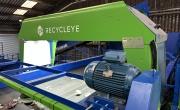Consumers ‘open’ to repair and reuse business models

Image: WRAP
Consumers are ‘open’ to new business models that feature the repair, reuse and trade-in of goods, new research from the Waste and Resources Action Programme (WRAP) has found.
The ‘Evidence of consumer demand for retailer services on electrical products that offer alternatives to new product purchase’ report was commissioned by WRAP to ‘demonstrate to retailers and other stakeholders that there is a case for evaluating alternatives to the conventional “sell-use-dispose” linear approach to meeting consumer demand’.
Specifically, the research looked at attitudes to resource efficient business models for retailers and manufacturers of: household appliances; consumer electronics; and DIY [‘Do it Yourself’] and gardening products.
The survey forms part of WRAP’s €3.5 million (£2.7 million) Resource Efficient Business Models (REBus) project to help develop and deliver business growth ‘within a more circular economy’ and encourage waste prevention. Earlier this year, it was announced that WRAP had secured £1.3 million EU LIFE+ funding (the European Union's environment fund) to increase work capacity in different markets, specifically: electrical and electronic products, clothing, furniture, and construction products.
Report findings
Undertaken by research and strategy consultancy Brook Lyndhurst, the research comprised a review of previous research, six ‘qualitative focus groups’, and a ‘national online of survey of 1,815 consumers in Great Britain’.
Additional booster samples were used in Wales and Scotland to ‘enable robust results to be reported for consumers in these two countries’. The results for Wales and Scotland are available in separate reports.
One of the key findings of the report was that ‘high proportions’ of consumers would be willing to use ‘circular’ business models, which keep products in use longer (such as trade-in, rentals, and repairs), as alternative to ‘linear’ models, which are based on a sell-use-dispose basis.
Consumers were particularly attracted to the idea of renting and trading-in DIY and gardening products, using a fixed-price repair service for household appliances, such as washing machines.
Trade-in business model
Despite that fact that just five per cent of consumers said they currently trade-in DIY and gardening products (or sell them on second-hand), 78 per cent of consumers said they would consider it. Further, 75 per cent of consumers said they would consider using this business model if a major retailer offered it.
The researchers found that a ‘key opportunity’ businesses could exploit is offering a trade-in service for unused electrical DIY and gardening products (preferably offering cash – as favoured by 67 per cent of consumers), as 35 per cent of consumers said they have items in the home or garden that they don’t use and haven’t disposed of. This is reportedly due to the fact that ‘consumers have some concerns that their old products may be rejected by retailers if they were to try to trade them in’.
As well as DIY and gardening goods, between 80 and 90 per cent of people said that they would consider using a trade-in service for electricals that they no longer use such as televisions, laptops and tablet computers. Electrical recyclers, major retailers and department stored were cited as being the preferred businesses for providing this service.
Fixed-price repair model
Currently, 17 per cent of people said they have paid to have their washing machines fixed, six per cent paid for their fridges to be brought into working order, and seven per cent have paid for vacuum cleaners.
However, 81 per cent said they would pay for their washing machines to be fixed if manufacturers of household appliances offered a repair service (dropping to 66 per cent for fridges and 43 per cent for vacuum cleaners).
Specifically, a fixed-price service (rather than a price based on the severity of the fault) would be most welcomed by consumers, with 71 per cent of people saying they would consider paying for a fixed-price repair of their washing machines, 67 per cent for fridges, and 56 per cent for vacuum cleaners.
Sixty-four per cent of people said they would be willing to use a fixed-price model for DIY and gardening goods.
The report adds that this, coupled with consumer confidence that repair would ‘extend the life of their product’, presents a ‘substantial potential consumer base and therefore significant business opportunity for the manufacturers and retailers of household appliances’.
Rental model
The rental model was also found to be a popular service with consumers, as although only one in five consumers (19 per cent) currently rent DIY and gardening of products, 69 per cent said they would be willing to use this model if it was available, particularly if they could rent well-known brands through a DIY retailer.
A third of people added that purchasing DIY and gardening tools was ‘a waste’, as they are used for short-term use and are left unused for long periods of time. However, However, around half of consumers still said they preferred to buy their DIY and gardening products.
When it comes to household appliances, around 58 per cent of people said they would be willing to pay to rent out their goods (with 39 per cent saying they would be ‘likely’ or ‘very likely’ to rent a well-known brand from a retailer), but 64 per cent said they wouldn’t know who offered this business models.
Second-hand model
Brook Lyndhurst found that 77 per cent of consumers would be willing to purchase second-hand DIY and gardening products (up from the current second-hand purchasing rate of 45 per cent), however there was concern over the longevity of previously owned products.
This differed from buying household appliances, where consumers felt ‘confident’ that the product would be in ‘full working order’. Indeed, when presented with a business case for buying second-hand models, between 81 and 87 per cent of people said they would buy previously-owned appliances, up from 26-32 per cent who said they would purchase these kinds of goods before seeing a model.
For electricals such as laptops and computers, between 22 and 34 per cent of people said they would buy second-hand (depending on the product), however if a major retailer offered it, between 64 and 79 per cent of people said they would be willing to buy second-hand.
Consumers noted however that they would want to be able to buy products that are not ‘too old’(less than three years old) even though they are second hand.
As with DIY and gardening products, consumers are much more likely to use this model if it offers second-hand products that are well-known brands.
Further work needed
The report concludes: ‘The one overriding note of caution is that each of the models do, to a greater or lesser extent, ask consumers to adopt relatively unfamiliar behaviours or to abandon well-established ones; that are underpinned by strong underlying social and cultural influences. Current consumer preferences to buy and own new products, replace rather than repair products, and hold on to old products they no longer use, represent significant barriers to the uptake of the models. It is worth noting however that the behaviour that showed the strongest potential for consumers letting go of was keeping hold of old products they no longer use…
‘There is a significant opportunity for retailers and manufacturers to build on the findings of this research, by undertaking further research to explore how attitudes towards the model vary between different consumer groups. While this research provides a robust picture of the attitudes of consumers as a whole to the models, the methodology was not designed to allow analysis of how these attitudes may differ between different types of consumers (e.g. consumers of different ages, genders or levels of income). Collecting this type of data would enable retailers and manufacturers to tailor the advertising and design of a business model to the specific group or groups of consumers who are most pre-disposed to use it.’
Read the ‘Evidence of consumer demand for retailer services on electrical products that offer alternatives to new product purchase’ report.





